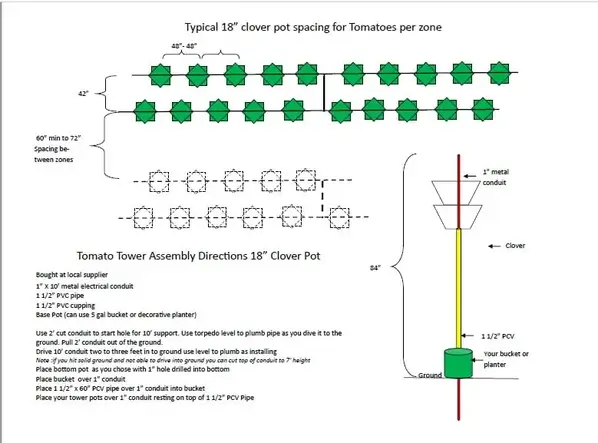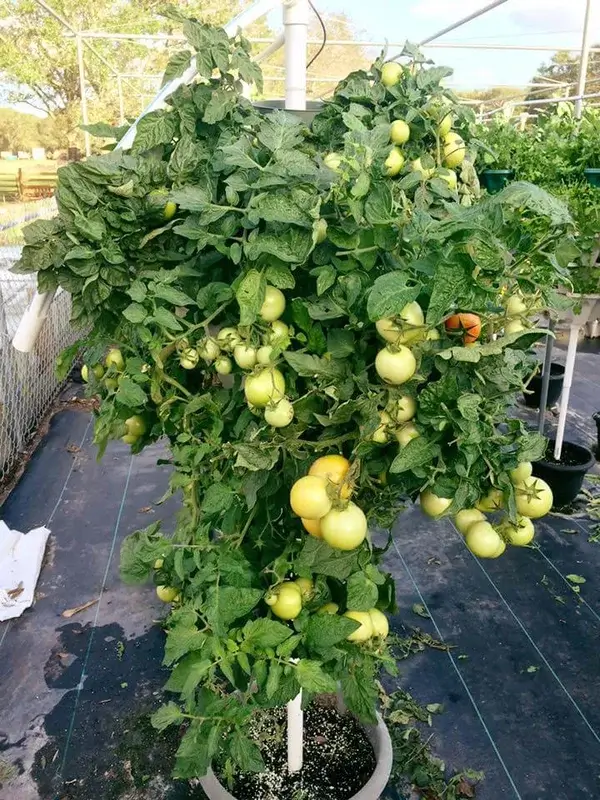Grow Tomatoes in hanging towers
Growing Tomatoes hydroponically in Hydroponic Towers….
- Will not require any staking!
- Will be harvested within 60-90 days after sowing
- Require full sun; ie. min 4 to 8 hours direct sunlight daily
- Consistent moistureo
- Regular feeding (Tomatoes are heavy feeders)
- Shelter from strong winds
- Regular pruning of ‘suckers’ & dead leaves (read below)
 Set-up
Set-up
- Sow 2 to 3 seeds per seedling cube
- Pinch off the weakest seedlings leaving 1 or maximum 2 seedlings per pot.
- Configure your towers as per the below set-up guide, with only 2 Mr Stacky planters per tower raised approx 2 meters high on a 19mm galvanized metal conduit pole.
- Ensure the tomatoes receive maximum sunlight. At least 4-6 hours p/day is required for optimal results.
- Ensure the nutrient contains plenty of nitrogen for the first month of growth. Read the nutrient guides
 Maintenance
Maintenance
- The beauty of growing hydroponic tomatoes in hanging towers, is you don’t require any staking.
- Simply allow the plant to grow upwards naturally, and then over a short period of time, the main stem will bend over the top of the planter under it’s own weight. At this stage, you simply allow it to continue to grow downwards on it’s own. You won’t need to interfere much in this process!
- As the plant grows downwards, simply stake the stem to the frame pole using soft twine while ensuring that the stem which hangs over the top of the tower is supported so it is not bearing the full weight of the plant.
- You can also use a lattice (optional) from the base of the tower to further support the stem.
- As the plant grows, continue to tie the plant to the lattuce and/or poles allowing the plant to bush out around the tower area.suc
- We recommend to pinch off some of the suckers in this method but not all of them. Suckers are the shoots that appears between the branch and the main stem of tomato plants, and allow only one or two main stems to grow. If you let this go unchecked, the plant will keep multiplying new leaves which can be difficult when you want it to convert it’s energy into producing fruit…. All about tomato suckers
- Within about 1 month, flowers will be formed and bees will be attracted.
- The more flowers you see, the better. By this stage you should be reducing the grow nutrient and increasing the bloom.
- As above, pruning is very important and will encourage higher yields. The aim is to have a single stem or 2 to max 3 main stems to ensure nutrients are directed to the fruit, instead of unwanted growing tips. Read this pruning guide in detail.
- Leave your tomatoes on the vine as long as possible. If any fall off before they appear ripe, place them in a paper bag with the stem up and store them in a cool, dark place
- Never place tomatoes on a sunny windowsill to ripen; they may rot before they are ripe!
- The perfect tomato for picking will be firm and very red in color, regardless of size, with perhaps some yellow remaining around the stem. A ripe tomato will be only slightly soft.
- To freeze, core fresh unblemished tomatoes and place them whole in freezer bags or containers. The skins will slip off when they defrost but they’re perfectly good for sauces etc
- After harvest, just pull the plant & mesh pot out of the whole and cut the root mass within the channel to remove all roots. You will be surprised by the length and density of the roots….
- It’s a very good idea to flush the entire system, cleaning any debris along the inside of the channels and replacing the resevoir with fresh clean water
- .
- Yellowing leaves? As plants grow, the lower leaves go yellow and die (pictured left). That is normal, so simply snip off any yellow or dead leaves often. The cleaner the plant the less susceptible it is to disease.
- However, if many leaves go yellow or the yellowing is accompanied by unhealthy looking blotches and spots, or if the plant wilts despite regular watering, the plant has probably contracted a bacterial, fungal or virus disease.
- Spraying with a copper-based fungicide such as Kocide or Fungus Fighter may help in some cases but usually the plant is doomed and ought be pulled out and disposed of.
- The tomato hornworm—a large, white-striped, green caterpillar—is an easy-to-spot pest. Just hand pick and destroy or read this guide
- Aphids, flea beetles, and cutworms may also attack your tomato plants.
- Late Blight is a fungal disease that can strike during any part of the growing season. It will cause grey, moldy spots on leaves and fruit which later turn brown. The disease is spread and supported by persistent damp weather. Infected plants should be destroyed. Avoid Blight With the Right Tomato.”
- Tobacco Mosaic Virus creates distorted leaves and causes young growth to be narrow and twisted, and the leaves become mottled with yellow. Unfortunately, infected plants should be destroyed (but don’t put them in your compost pile).
- Cracking: When fruit growth is too rapid, the skin will crack. This usually occurs in extreme humidity or rainy periods in conjunction with dry periods. Keep an eye on your ripening tomatoes and pick slightly early is this is a problem
- Blossom end rot creates Black, indented area on bottoms of fruit, most likely to affect your first picking. Keep moisture levels constant and try using a calcium solution on leaves and fruit.
- Blossom Drop: Reduce by protecting the plant from too low or too high temperatures, high relative humidity, and excessive wind. Misshapen fruit can occur due to poor pollination.


About the Author
Mr Stacky is the leader in Tower Garden Systems in Australia, specializing in commercial hydroponic farming, urban farming & residential vertical gardening.
Find out how he can help you achieve your food production goals. Contact Brian

